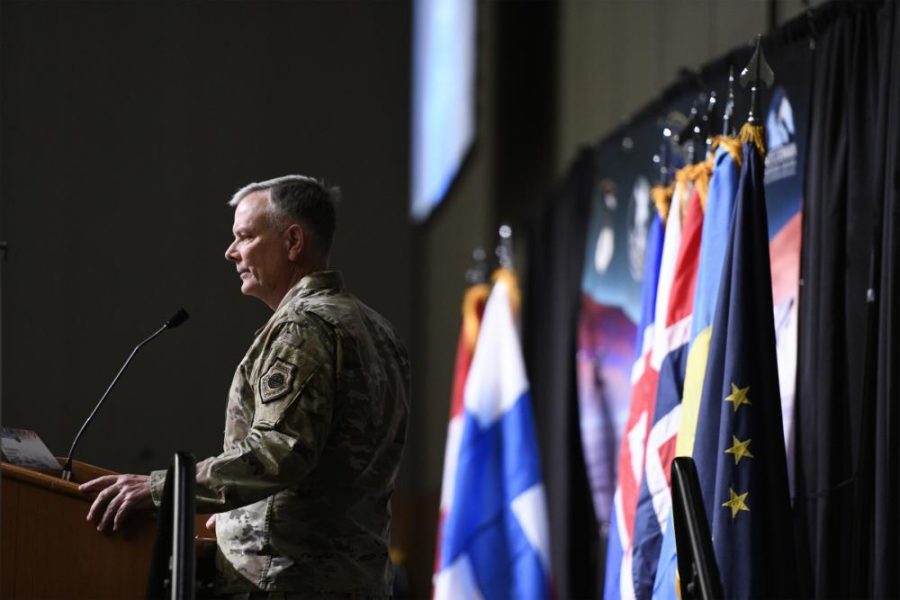Nearly two months after acknowledging that previous Chinese surveillance balloons slipped into U.S. airspace undetected by the Pentagon, the head of North American Aerospace Defense Command (NORAD) and U.S. Northern Command (NORTHCOM) reiterated his warning to lawmakers that his command has major awareness gaps which could limit decision-makers’ ability to react to approaching threats.
To close the gap, Air Force Gen. Glen D. VanHerck stressed the need for over-the-horizon radars; integrating space-based and undersea surveillance to form a more comprehensive defense picture; and accelerating the development process to put those capabilities in the field more quickly.
VanHerck has made such appeals throughout his tenure as NORTHCOM and NORAD chief, but the international uproar of the Chinese surveillance balloon transiting the continental U.S. earlier this year has driven new attention to the issue.
“I have concerns, as I have articulated for three years, about my ability to provide threat warning and attack assessment with the threats to our homeland,” VanHerck said during a hearing with the Senate Armed Services Committee on March 23. “That increases the risk of escalation and strategic deterrence failure. Those are significant challenges for me.”
VanHerck voiced similar concerns last month after telling reporters that it was the intelligence community, not NORAD, which previously detected Chinese surveillance balloons approaching North America.
“As NORAD commander, it’s my responsibility to detect threats to North America,” he said at the time. “I will tell you that we did not detect those threats. And that’s a domain awareness gap that we have to figure out.”
In a statement for lawmakers, VanHerck specifically mentioned over-the-horizon radar (OTHR) as a “proven, affordable technology that will ensure our ability to detect threats from surface to space in the approaches to North America.”
Both the U.S. and Canadian militaries have invested in OTHR systems, but VanHerck stressed that the two governments need to move as quickly as possible to put those systems in the field to detect growing threats from China and Russia such as cruise missiles, hypersonic weapons, and non-kinetic capabilities to target critical military and civilian infrastructure.
“Rather than fielding the capabilities in eight to 10 years, maybe we can shorten that to four to five years,” he said. “ … And by the way, I need Canada to do the same thing. A fielding of a capability a decade from now is not where we need to be.”
VanHerck also proposed investing $211 million in nine long-range mobile radars that would help NORAD and NORTHCOM “plug the gaps when we have radar failures or to get after critical defense infrastructure if tasked to do that,” he said. “As we move around the country, I can move those radars to get me additional domain awareness.”
Aside from missiles and balloons, though, VanHerck said his largest domain awareness gap and his biggest concern is actually cyber domain awareness. As NORTHCOM chief, VanHerck’s cyber authorities are somewhat limited: Much of the cyberspace for America’s critical infrastructure lies outside of the authority of the military’s U.S. Cyber Command and outside of federal cyberspace overseen by the Cybersecurity and Infrastructure Agency.
But federal law, specifically Section 702 of the Foreign Intelligence Surveillance Act, which allows the government to conduct surveillance on foreigners outside the United States, has been a “crucial” tool for spotting possible threats to the homeland, VanHerck said. That capability allows U.S. cyber officials to “fill those domain awareness gaps,” he explained.
Future Capabilities
The future of homeland defense may look “vastly different than what we see today,” VanHerck suggested. “It’s likely including autonomous platforms, airborne, maritime platforms, unmanned platforms with domain awareness sensors and vectors that are kinetic and non-kinetic.”
Integrating the data generated by all those platforms and OTHR systems will require “fusing it into an integrated picture, a globally integrated picture that allows us to see threats globally before they become threats here in the homeland and tie that to an integrated air and missile defense and also into vectors which are non-kinetic and also kinetic.”
”Less kinetic” effects, such as deception, denial and electronic warfare will play a large role in the future, VanHerck predicted, with kinetic weapons still protecting critical areas. He also emphasized that defending the homeland will require not just NORAD and NORTHCOM, but also integration with state, municipal, and commercial entities.
However, sharing data between agencies may grow more difficult in areas like the Arctic, where long-distance communication systems are often unreliable, he explained. In the past, VanHerck has called for testing out SpaceX’s constellation of Starlink satellites to overcome those issues, and he made a similar call at this hearing.
“Alaska may be the most strategic location on the planet,” he said. “Short to the Indo-Pacific, short to the EUCOM AOR. Shortest avenue approach for ballistic missiles from Russia, potentially China and [North Korea] to our homeland.”
Receding ice has allowed Chinese and Russian ballistic missile submarines to approach closer to Alaska, making it a much more vulnerable space, so VanHerck hopes the Air Force can accelerate bringing the E-7 Wedgetail online to help give NORAD greater awareness of threats there. But responding to threats in the Arctic will also take a much more robust infrastructure, he said: icebreakers, longer runways, billeting, weapons storage, fuel storage, and platforms that can survive the weather.
“The bottom line is if you can’t detect something, you can’t defeat it, and you certainly can’t deter,” VanHerck said. “Russia and China particularly have developed capabilities to hold our homeland at risk, to reduce our decision space, delay and disrupt our flow … and my ability to detect those threats, whether they be undersea to on orbit and in cyberspace, has not kept pace with the threat.”

